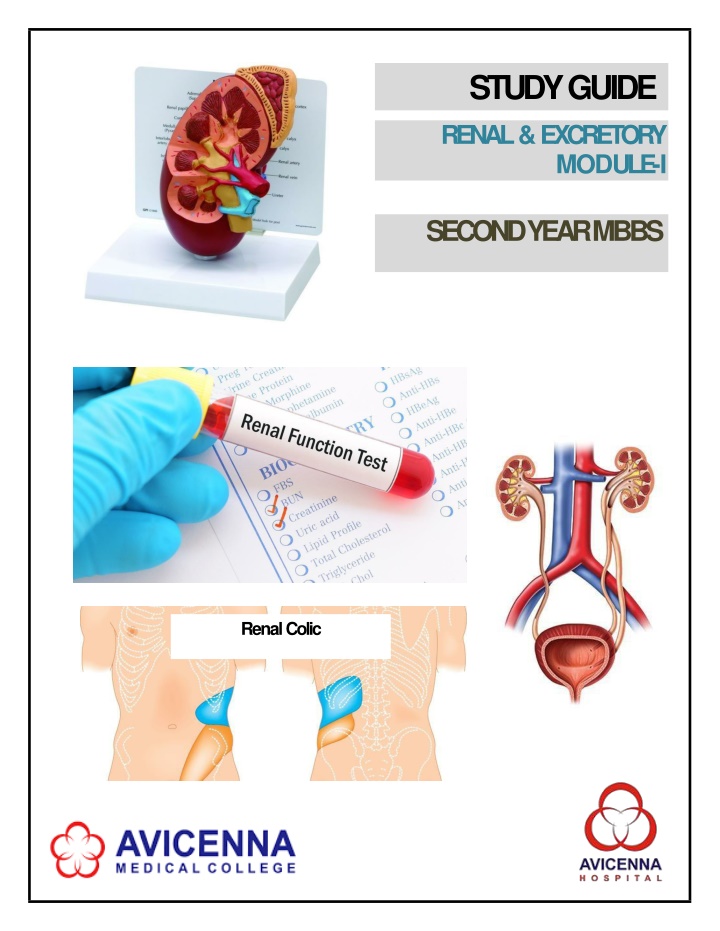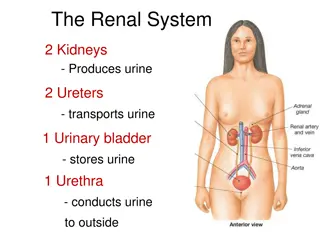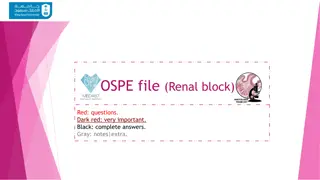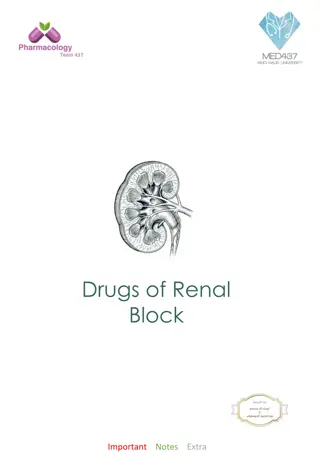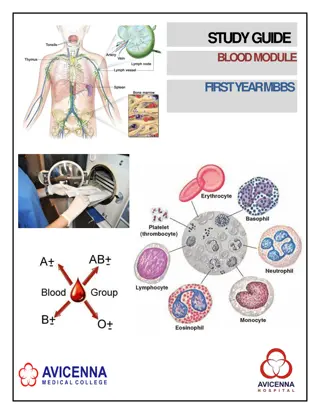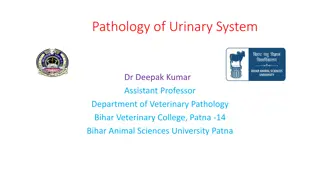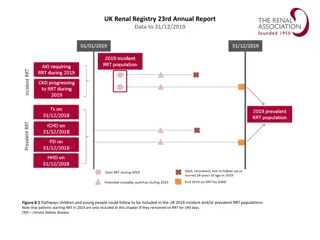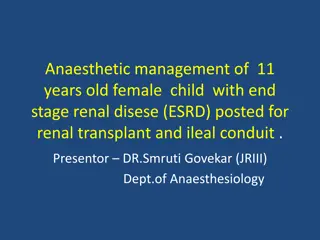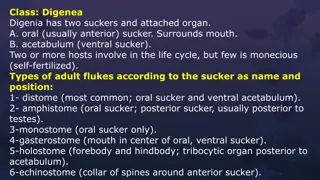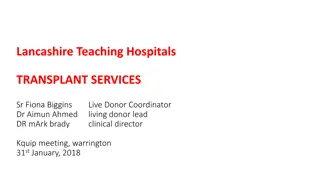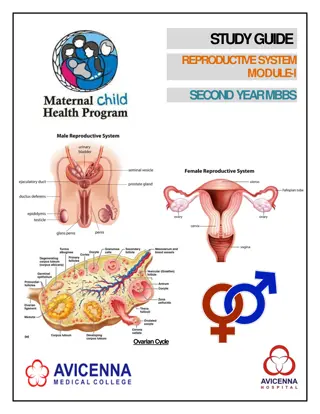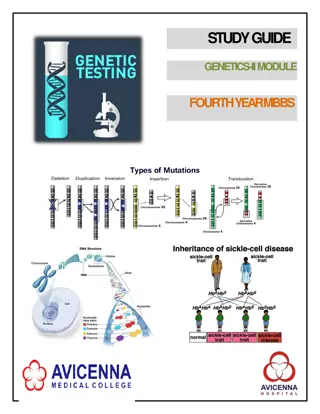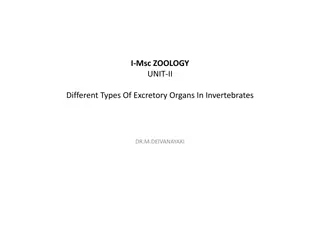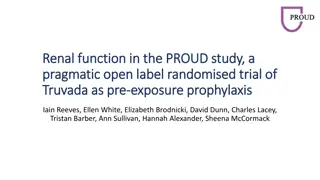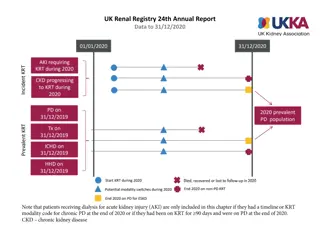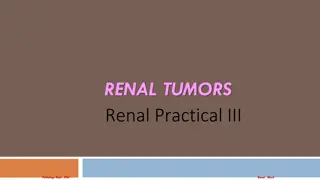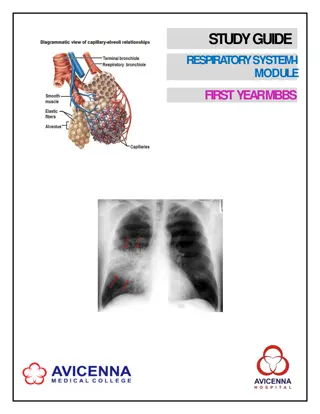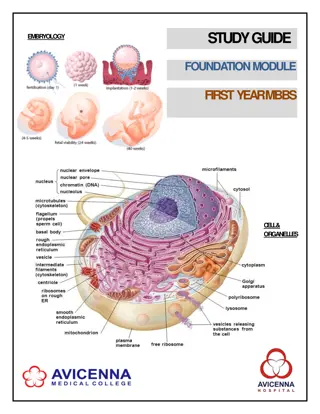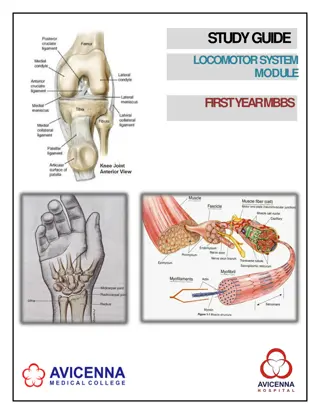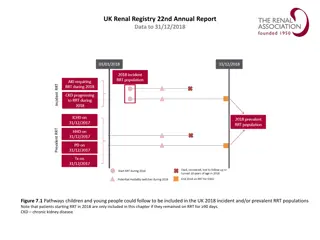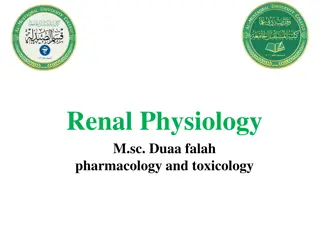Study Guide for Renal and Excretory System Module - Avicenna Medical College
The study guide provides a comprehensive overview of the Renal and Excretory System Module for second-year MBBS students at Avicenna Medical College. It covers the importance of the module, learning methodologies, assessment methods, and examination rules and regulations. The guide also includes details on the curriculum framework and integrated teaching approach aimed at linking basic science knowledge to clinical problems.
Download Presentation

Please find below an Image/Link to download the presentation.
The content on the website is provided AS IS for your information and personal use only. It may not be sold, licensed, or shared on other websites without obtaining consent from the author.If you encounter any issues during the download, it is possible that the publisher has removed the file from their server.
You are allowed to download the files provided on this website for personal or commercial use, subject to the condition that they are used lawfully. All files are the property of their respective owners.
The content on the website is provided AS IS for your information and personal use only. It may not be sold, licensed, or shared on other websites without obtaining consent from the author.
E N D
Presentation Transcript
STUDYGUIDE RENAL &EXCRETORY MODULE-I SECOND YEARMBBS RenalColic
2nd YEAR MBBS RENAL & EXCRETORYMODULE-I AVICENNA MEDICAL COLLEGE STUDY GUIDE FOR RENAL AND EXCRETORYMODULE-I Page No 3 4 5 7 7 8 13 15 17 18 S.No CONTENTS 1 2 3 4 Overview Introduction to StudyGuide LearningMethodologies Module 2: Renal and ExcretorySystem-I Importance of Renal and ExcretorySystem Objectives and Learningstrategies LearningResources AssessmentMethods Modular Examination Rules and Regulations(AVMC) Schedule 4.1 4.2 5 6 7 8 Page | 2
2nd YEAR MBBS RENAL & EXCRETORYMODULE-I AVICENNA MEDICAL COLLEGE Year:One Duration: 4 weeks Timetable hours: Lectures, Case-Based Learning (CBL), Team based Learning (TBL), Self-Study, Practical, Skills, Demonstrations, Field Visits, Visit to Wards& Laboratory MODULE INTEGRA TEDCOMMITTEE MODULECOORDINATOR: CO-COORDINATORS: Professor Dr. Zubair Ahmad(Biochemistry) Professor Dr. Rubina Hafeez (Pathology) Professor Dr.Rehana Shahid(Anatomy) DEPARTMENTS & RESOURCE PERSONS FACILITA TINGLEARNING BASIC HEALTHSCIENCES CLINICAL AND ANCILLARYDEPARTMENTS FAMILYMEDICINE Professor Dr. Muhammad Luqman ANATOMY Professor Dr.Rehana Shahid BIOCHEMISTRY Professor Dr. Zubair Ahmad MEDICALEDUCATION Professor Dr. Waheed Ahmad COMMUNITYMEDICINE Professor Dr. Rana Muhammad Akhtar Khan INTERNALMEDICINE Dr. Muhammad Usman Amir PATHOLOGY Endocrinology Prof. Dr. Waheed Ahmed Professor Dr. Rubina Hafeez PHYSIOLOGY Professor Dr. Binyamin Ahmad PHARMACOLOGY Professor Dr. Rana Tariq Mehmood AVMCMANAGEMENT Professor Dr. Gulfreen Waheed, PrincipalAVMC Brig.Dr. Gul e Rana , Director AVMC Dr. Sadia Awan Dr. Muhammad Muzzammil Sadiq Dr. Usama Bin Ishtiaq STUDY GUIDE COMPILEDBY: Department of Health CareEducation Page | 3
2nd YEAR MBBS RENAL & EXCRETORYMODULE-I AVICENNA MEDICAL COLLEGE INTRODUCTION WHAT IS A STUDYGUIDE? It is an aidto: Inform students how student learning program of the module has beenorganized Helpstudentsorganize andmanagetheirstudiesthroughoutthemodule Guide students on assessment methods, rules andregulations THE STUDYGUIDE: Communicates information on organization and management of themodule. Thiswill helpthestudentto contactthe rightpersonin caseof anydifficulty. Definestheobjectiveswhich areexpectedto beachieved at theendof themodule. Identifies the learning strategies suchasInteractive Lectures,smallgroupteachings, clinical skills, demonstration, tutorial and casebasedlearning that will be implemented to achieve the module objectives. Provides a list of learning resources such as books, computer assisted learning programs, web- links,journals,forstudentsto consultin orderto maximize their learning. Highlights information on the contribution of continuous on the student s overallperformance. Includes information on the assessment methods that will be held to determine every student s achievement ofobjectives. Focuses on information pertaining toexamination policy, rules and regulations. CURRICULUMFRAMEWORK Students will experience integrated curriculum in 4th semesters at LNMC in accordance with theJSMU guidelines and most recent developments that have an impact on individualhealth. INTEGRATED CURRICULUM comprises of system-based modules such as GIT & Liver-I, Renal & Excretory System-I and Reproduction-I which links basic science knowledge to clinical problems. Integrated teaching means that subjects are presented as a meaningful whole. Students will be able to have betterunderstandingof basicscienceswhentheyrepeatedlylearn in relation to clinical examples. Case-based discussions, computer-based assignments, early exposure to clinics, wards, and skills acquisition in skills lab and physiotherapy department are characteristics of integrated teachingprogram. Page | 4
2nd YEAR MBBS RENAL & EXCRETORYMODULE-I AVICENNA MEDICAL COLLEGE LEARNINGMETHODOLOGIES Thefollowing teaching/ learningmethodsareusedto promotebetterunderstanding: InteractiveLectures Hospital / Clinic visits Small Group Discussion Case-BasedLearning Practicals Skillssession E-Learning Self-DirectedLearning TBL INTERACTIVELECTURES Inlargegroup,the Interactive Lecturerintroducesatopic or commonclinical conditions andexplains the underlying phenomena through questions, pictures, videos of patients interviews, exercises, etc. Students areactivelyinvolved in the learning process. HOSPITALVISITS: In small groups, students observe patients with signsand symptoms in hospital or clinical settings.Thishelpsstudentsto relate knowledge of basicandclinical sciencesof the relevant module. Page | 5
2nd YEAR MBBS RENAL & EXCRETORYMODULE-I AVICENNA MEDICAL COLLEGE SMALLGROUPDISCUSSION(SGD):Thisformat helps students to clarify concepts acquire skills or attitudes. Sessions are structured with the help of specific exercises such as patient case, interviews or discussion topics. Students exchangeopinions and apply knowledgegained from Interactive Lectures, tutorials and self study.Thefacilitator role isto askprobing questions,summarize,or rephraseto help clarify concepts. CASE- BASED LEARNING: A small group discussion format where learning is focused around a series of questions based on a clinical scenario. Students discuss and answer the questions applying relevant knowledge gainedin clinical andbasichealth sciencesduring themodule. PRACTICAL: Basic science practicals related to anatomy, biochemistry, pathology, pharmacology and physiologyarescheduledfor studentlearning. SKILLSSESSION:Skills relevant to respective module are observed and practiced where applicable in skills laboratory or DepartmentofPhysiotherapy. SELFDIRECTEDLEARNING:Students assume responsibilities of their own learning through individual study, sharing and discussing with peers, seeking information from Learning Resource Center, teachers and resource persons within and outside the college. Students can utilize the time within the college scheduled hoursofself-study. TEAM BASED LEARNING: Team-based learning (TBL) is a structured form of small-group learning that emphasizes student preparation out of class and application of knowledge in class. Students are organized strategically into diverse teams of 5-7 students that work together throughout the class. Before each session/class, students prepare by reading prior to class. In class students are given different tasks or test where they work asteam. Apart from attending daily scheduled sessions, students too should engage in self-study to ensure that all the objectives are covered. Page | 6
2nd YEAR MBBS RENAL & EXCRETORYMODULE-I AVICENNA MEDICAL COLLEGE MODULE 2: RENAL & EXCRETORYSYSTEM-I Rationale: Renal system and excretory system is responsible for the body toget rid of waste and toxic substances. In this module the renal and excretory system will be examined in detail with emphasis on how the renal system develops and functions on a cellular level as well as the mechanisms that underlie renal diseases such as electrolyte imbalance, dehydration, renal hypertension, renal failure, polycystic kidney, nephrotic and nephriticsyndrome. This module will enable the students of second year to recognize the clinical presentations of common renal diseases and relate clinical manifestations to basic sciences. It will be further revisited in the followingyears. Page | 7
2nd YEAR MBBS RENAL & EXCRETORYMODULE-I AVICENNA MEDICAL COLLEGE COURSE TOPICS, OBJECTIVES ANDSTRA TEGIES LEARNING STRATEGY TOPICS &OBJECTIVES FACULTY 1. Overview ofKidney a. Explain the gross &clinical anatomy of kidneys with neurovascular supply and lymphaticdrainage b. Identify the histological features ofkidney c. Define renalpain d. Name the relevant disorders of renalpain e. Discuss the causes and clinical presentation of renalpain f. List the relevant investigations of renalpain g. Describe Body fluid compartments with itscomposition and edema 2. Function ofkidney Small Group Discussion Practical Anatomy Anatomy SmallGroup Discussion Nephrology Small Group Discussion Physiology a. Explain functions of different segments ofkidney InteractiveLecture b. Discuss Glomerular Filtration Rate (GFR) and thefactors regulatingit c. Discuss secretion and absorption at Proximalconvoluted tubules d. Discuss loop of Henle with regard to secretionand absorption at differentsegments e. Discuss processing of tubular fluid at DistalConvoluted Tubules and collectingtubules f. Discussrole of kidneyin regulation of arterialblood pressure g. Discuss dehydration, over hydration and compositionand use of ORS along with various intravenous infusions suchas normal saline, ringer lactate, 5%, 10%, 25% glucose, amino acids solutions,hemaxcel h. Describe mechanisms of concentration and dilution of urine i. Discuss the acidification ofurine j. Describe micturitionreflex k. Discussthe role of ureainurineformation 3. Development of kidney and congenitalanomalies InteractiveLecture InteractiveLecture InteractiveLecture Physiology InteractiveLecture InteractiveLecture SmallGroup Discussion Physiology InteractiveLecture Physiology InteractiveLecture a. Describe the development ofkidneys InteractiveLecture Anatomy b. Recognize the congenital anomalies of kidneys InteractiveLecture c. Describe Congenital anomalies of kidney and lowerurinary system Pathology InteractiveLecture Page | 8
2nd YEAR MBBS RENAL & EXCRETORYMODULE-I A ICENNA MEDICAL COLLEGE d. Classify cystic diseases of kidney e. Discuss the Pathogenesis and morphology ofimportant cystic diseases of kidney 4. Development of Excretory System and congenitalanomalies InteractiveLecture a. Describe the development ofureter, urinary bladder and urethra. b. Recognize the congenital anomalies of ureters, urinary bladdar andurethra. 5. Gross, microscopic & clinical anatomy of ExcretorySystem InteractiveLecture Anatomy InteractiveLecture a. Demonstrate the histological features of ureter,urinary bladder andurethera b. Explain the gross & clinical anatomy of ureters & urinary bladder with neurovascular supply and lymphaticdrainage Anatomy Practical Small Group Discussion Anatomy c. Describe the structure, parts and location ofmale and femaleurethra Small Group Discussion 6. Normal and abnormal constituents ofurine a. Detect the normal and abnormal constituents of urine and its biochemicalsignificance b. Estimate the urea in the givensample c. Estimate the Creatinine in thegiven sample d. Estimate the Uric acid in the givensample 7. Hematuria Biochemistry Practical a. Definehematuria b. Discuss the clinical presentation and causes ofhematuria c. Name the relevant investigations ofhematuria d. Discuss the complications ofhematuria Renal failure anddialysis InteractiveLecture 8. a. Define renalfailure b. Discusstheclinical presentation of renal failure c. List the common investigations for renalfailure d. Identify the complications ofrenal failure e. Definedialysis f. Identify signs and symptoms ofdialysis g. List the possible indications ofdialysis h. Recognizethe importanceof dialysisanditstypesincaseof renalfailure i. Discuss the complications ofdialysis 9. Imaging of urinarytract InteractiveLecture Nephrology InteractiveLecture a. Explain the radiographs and other imaging techniquesof Radiology InteractiveLecture Page | 9
2nd YEAR MBBS RENAL & EXCRETORYMODULE-I AVICENNA MEDICAL COLLEGE urinarysystem b. Discuss the images of urinary tract 10. Surface anatomy / urinarycatheterization a. Discuss the surface anatomy of kidney, ureter andurinary bladder b. Perform Foleys catheterization on a manikin using correct aseptictechniques Small Group Discussion Small Group Discussion with hands- on Anatomy SkillsLab 11. Role of kidney in watermetabolism a. Discuss the role of water andpH Biochemistry InteractiveLecture b. Describe regulation of water balance throughhormones acting onkidney 12. Role of kidney in maintaining acid basebalance Physiology InteractiveLecture a. Discuss the role of renal system in acidbase balance Biochemistry InteractiveLecture 13. Role of minerals (Na, Cl & K) in maintaining metabolism& role in water & electrolytebalance a. Explain electrolyte metabolism that are sodium &chloride and their disturbances b. Explain electrolyte metabolism that are potassium & phosphate and their disturbances c. Explain the evaluation ofelectrolytes 14. Renal functiontests InteractiveLecture Biochemistry InteractiveLecture Nephrology InteractiveLecture a. Discuss the renal function test and its role indiagnosis of renal disorders b. Explain the importance of renal function andother important laboratory test in case of chronic kidneydisease 15. Purine and Pyrimidine metabolism and relateddisorders Biochemistry InteractiveLecture Nephrology InteractiveLecture a. Discuss the purine metabolism-I InteractiveLecture b. Discuss the purine metabolism-II and its disorders InteractiveLecture Biochemistry c. Discuss the pyrimidine metabolism and itsdisorders InteractiveLecture 16. Renal diseases, Uremia and Glomerulardiseases a. Discuss clinical manifestations of renal diseases anduremia InteractiveLecture Pathology b. Describe the Pathological responses to glomerular injury InteractiveLecture Page | 10
2nd YEAR MBBS RENAL & EXCRETORYMODULE-I AVICENNA MEDICAL COLLEGE Discuss Pathogenesis of glomerular diseases and mediators of glomerularinjury 17. Nephroticsyndrome c. InteractiveLecture a. Define nephroticsyndrome Pathology InteractiveLecture b. Describe various glomerulonephritis in this contextwith clinical and morphological features ofeach 18. Nephriticsyndrome Pathology Small groupdiscussion a. Define nephritic syndrome Pathology InteractiveLecture b. Describe various glomerulonephritis in this context with clinical and morphological features ofeach 19. Pyelonephritis Pathology Small groupdiscussion a. DefinePyelonephritis b. Describe the various Etiologicalfactors c. Differentiate between different types ofPyelonephritis d. Discuss the types ofPyelonephritis 20. Tubulo-interstitialdisease Pathology InteractiveLecture a. Define tubulointerstitialdiseases b. Classify tubulointerstitial diseases c. Describe various types of tubulointerstitialdiseases Pathology InteractiveLecture 21. Urinary Tract Infections(UTI) a. List the causative organism of UTI in various agegroups b. Describe the clinical and morphological features ofUTI 22. Role of diuretics and NephrotoxicDrugs Microbiology Small groupdiscussion a. Diureticdrugs Classify diuretic drugs Explain thesiteof action andmechanismof action of different classes ofdiuretics Discuss the therapeutic uses of differentclasses of diuretics Explain the systemic effects and adverse effectsof diuretics Compare the thiazide diuretics, loop diuretics and potassium sparingdiuretics b. Nephrotoxicdrugs Classify drug induced renal disorders andcauses List the risk factors fornephrotoxicity Discuss manifestations of nephrotoxicity anddiagnosis Explain some common drug inducednephrotoxicity InteractiveLecture Pharmacology Case-BasedLearning Page | 11
2nd YEAR MBBS RENAL & EXCRETORYMODULE-I AVICENNA MEDICAL COLLEGE caused by Aminoglycosides, NSAIDs, Amphotericin B, Sulphonamides, ACE inhibitors, Methicillin and radiographic contrastmedia. Describe drug-induced renalfailure 23. Introduction toBiostatistics a. Define Biostatistics, measures of central tendency& Measures of dispersion b. List the uses & importance ofbiostatistics c. Describe the concept of frequency, cumulativefrequency 24. Data and itstype a. Classify data with examples b. Describe the process of measurement ofvarious types of data c. Discuss techniques and procedure to deal withdata collection InteractiveLecture InteractiveLecture\ Small group discussion 25. VitalStatistics a. Discussthe role of vital statistics in healthstatusof country b. Describe Vital statistics registration in developingcountries c. Discussthe situationof vital statisticsin Pakistan InteractiveLecture 26. Measure of Centraltendency Communit y Medicine a. Discuss the Advantages and disadvantages of measuresof centraltendency InteractiveLecture/ Smallgroup discussion 27. Measure ofdispersion a. Discuss the Advantages and disadvantages of measuresof dispersion InteractiveLecture/ Smallgroup discussion 28. Method of datapresentation a. Describe the type of datapresentation b. List the advantages of tabular & graphicpresentations InteractiveLecture 29. Interpretation ofdata a. Evaluate criteria of interpretation ofdata b. Discuss the steps of datainterpretation c. Differentiate between association andcausation InteractiveLecture Page | 12
2nd YEAR MBBS RENAL & EXCRETORYMODULE-I AVICENNA MEDICAL COLLEGE LEARNINGRESOURCES SUBJECT RESOURCES A. GROSSANATOMY 1. K.L. Moore, Clinically OrientedAnatomy 2. Neuro Anatomy by RichardSnell B. HISTOLOGY 1. B. Young J. W. Health Wheather s FunctionalHistology C. EMBRYOLOGY 1. Keith L. Moore. The DevelopingHuman 2. Langman s Medical Embryology ANATOMY A. TEXTBOOKS 1. Harper s IllustratedBiochemistry 2. Lehninger Principle ofBiochemistry 3. Biochemistry byDevlin BIOCHEMISTRY A. TEXTBOOKS 1. Community Medicine byParikh 2. Community Medicine by MIllyas 3. Basic Statistics for the Health Sciences by Jan WKuzma COMMUNITYMEDICINE A. TEXTBOOKS 1. Robbins & Cotran, Pathologic Basis of Disease, 9thedition. 2. Rapid Review Pathology, 4th edition by Edward F. GoljanMD PATHOLOGY/MICROBIOLOGY 1. http://library.med.utah.edu/WebPath/webpath.html 2. http://www.pathologyatlas.ro/ A. TEXTBOOKS 1. Lippincot IllustratedPharmacology 2. Basic and Clinical Pharmacology by Katzung PHARMACOLOGY A. TEXTBOOKS 1. Textbook Of Medical Physiology by Guyton AndHall 2. Ganong S Review of MedicalPhysiology 3. Human Physiology by LauraleeSherwood 4. Berne & LevyPhysiology 5. Best & Taylor Physiological Basis of MedicalPractice B. REFERENCEBOOKS 1. Guyton & Hall PhysiologicalReview 2. Essentials Of Medical Physiology byJaypee 3. Textbook Of Medical Physiology byInduKhurana 4. Short Textbook Of Physiology byMrthur 5. NMSPhysiology PHYSIOLOGY Page | 13
2nd YEAR MBBS RENAL & EXCRETORYMODULE-I AVICENNA MEDICAL COLLEGE OTHER LEARNINGRESOURCES Students will be involved in Practical sessions and hands-on activitiesthat link with therenalandexcretorymoduleto enhancethe learning. Hands-on Activities/Practical Utilize thelabto relatethe knowledge to thespecimensandmodels Labs available. A skills lab provides the simulators tolearn the basic skills and SkillLab procedures. This helps build the confidence to approach thepatients. Videofamiliarize thestudentwith the proceduresandprotocols to assist Videos patients. To increase the knowledge students should utilize the availableinternet resources and CDs/DVDs. This will be an additional advantage to increase learning. Computer Lab/CDs/DVDs/Internet Resources: Self Learning is scheduled to search for information tosolve cases, read through different resources and discuss among the peers and with the faculty to clarify theconcepts. SelfLearning Page | 14
2nd YEAR MBBS RENAL & EXCRETORYMODULE-I AVICENNA MEDICAL COLLEGE ASSESSMENTMETHODS: Theory: o Best Choice Questions (BCQs) also known as MCQs (Multiple Choice Questions) are used to assess objectives covered in eachmodule. A BCQ has a statement or clinical scenario followed by four options (likelyanswer). Students after reading the statement/scenario select ONE, the most appropriate response from the given list ofoptions. Correct answer carries one mark, and incorrect zero mark . There is no negative marking. Studentsmarktheirresponsesonspecifiedcomputer-based/OMRsheetdesignedforLAVMC OSPE/OSCE: Objective Structured Practical/ClinicalExamination: Eachstudentwill beassessedonthe samecontentandhavesametimeto completethe task. Comprise of 12-25stations. Each station may assess a variety of clinical tasks, these tasks may include history taking, physical examination, skills and application of skills andknowledge Stations are observed, unobserved, interactive and reststations. Observed and interactive stations will be assessed by internal orexternal examiners. Unobserved will be static stations in which there may be an X-ray, Labs reports, pictures, clinical scenarioswith relatedquestionsforstudentstoanswer. Rest station is a station where there is no task given and in this time student can organize his/her thoughts. InternalEvaluation Students will beassessedto determine achievement of moduleobjectivesthroughthefollowing: Module Examination: will be scheduled on completion of each module. The method of o examination comprises theory exam which includes BCQs and OSPE (Objective StructuredPractical Examination). Graded Assessment of students by Individual Department: Quiz, viva, practical, assignment, small o group activities such as CBL, TBL, TOL, online assessment, ward activities, examination, and log book. Marksof bothmodular examinationandgradedassessmentwill constitute 20%weightage. As per UHS policy, this 20% will be added by JUHS o Final TheoryExamination. Page | 15
2nd YEAR MBBS RENAL & EXCRETORYMODULE-I AVICENNA MEDICAL COLLEGE Example : Number of Marks allocated for Final Theory and Internal Evaluation InternalEvaluation (Class test +Assignments + Modular Exam) 20% FinalExamination TheoryMarks Total(Theory) 80% 100% FormativeAssessment Individual department may hold quiz or short answer questions to help students assess their own learning. The marks obtained are not included in the internalevaluation More than 75% attendance is needed to sit for the modularexaminations Page | 16
2nd YEAR MBBS RENAL & EXCRETORYMODULE-I AVICENNA MEDICAL COLLEGE MODULAR EXAMINATION RULES & REGULATIONS(LNH&MC) Studentmustreportto examinationhall/venue, 30 minutesbeforetheexam. Exam will begin sharp at the giventime. No student will be allowed to enter the examination hall after 15 minutes of scheduled examinationtime. Studentsmust sitaccordingto theirroll numbersmentioned ontheseats. Cell phones are strictly not allowed in examinationhall. If anystudentisfoundwith cell phonein anymode(silent, switchedoff oron)he/shewill benot be allowed to continue theirexam. No students will be allowed to sit in exam without University Admit Card, AVMCCollege ID Card and LabCoat Student must bring the following stationary items for the exam: Pen, Pencil, Eraser, and Sharpener. Indiscipline in the exam hall/venue is not acceptable. Students must not possess any written materialorcommunicatewith theirfellowstudents. UHS GradingSystem It will be based on GPA 4system Marks obtained in Percentagerange NumericalGrade AlphabeticalGrade 80-100 4.0 A+ 75-79 4.0 A 70-74 3.7 A- 67-69 3.3 B+ 63-66 3.0 B 60-62 2.7 B- 56-59 2.3 C+ 50-55 2.0 C <50 Un-grade-able 0 U A candidate obtaining GPA less than 2.00 (50%) is declared un-graded(fail). Cumulativetranscriptisissuedat the endof clearance of all modules. Page | 17
